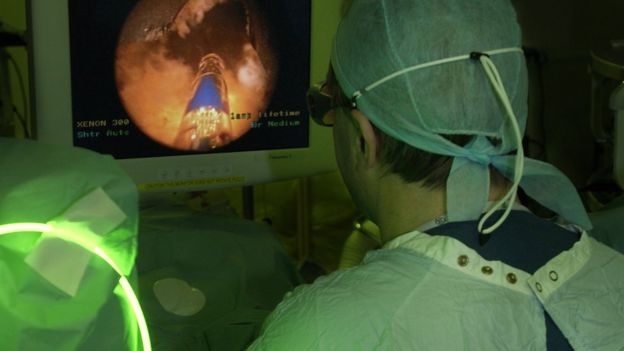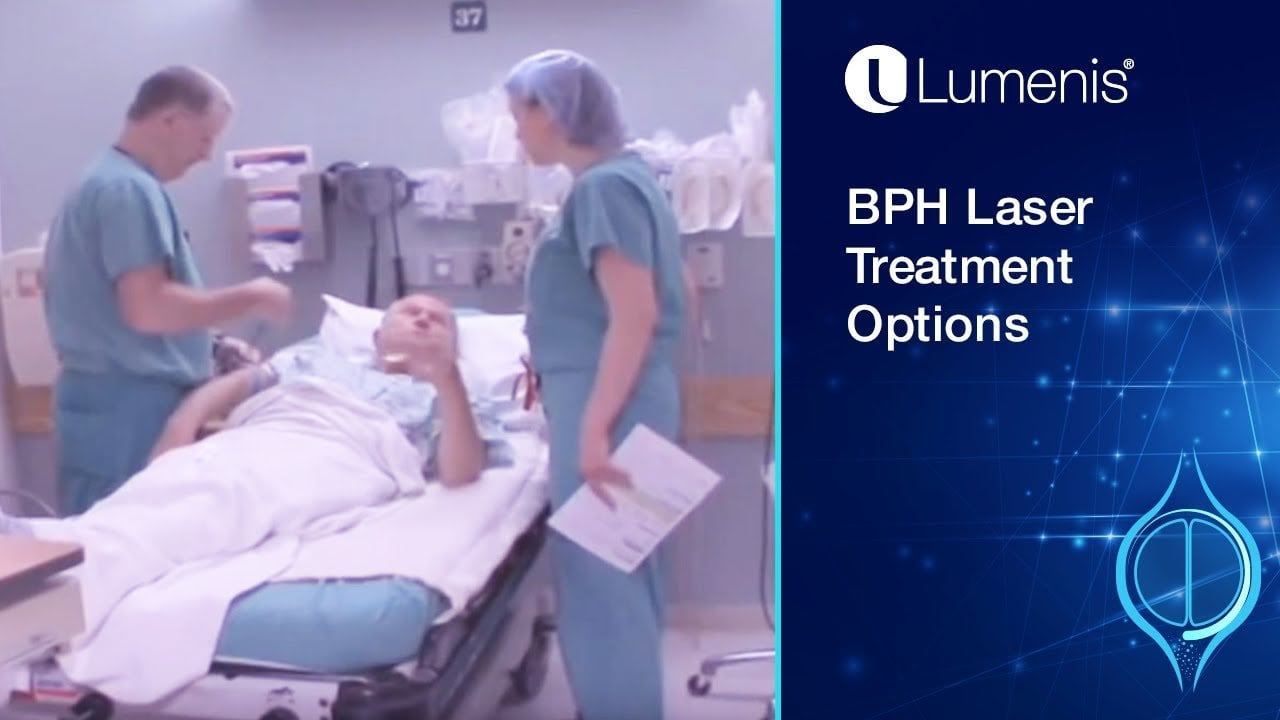Greenlight Laser Therapy Animation
Although it is a benign condition that becomes more common as men age, BPH can be distressing. As the prostate gland enlarges, it squeezes the urethra, the tunnel that carries urine from the bladder out through the penis.
Signs of BPH are:
- urgent or frequent need to urinate during the day and at night
- a slow or weak urinary stream
- difficulty completely emptying the bladder
- difficulty or delay in starting urination
- a urinary stream that starts and stops
When medical management of BPH symptoms is ineffective or the side effects of medications cannot be tolerated, men may choose a surgical procedure to correct the problem.
What Can You Expect The Day Of Your Procedure
On the day of your procedure, you will come to the treatment center. You should have someone drive you home since this is an outpatient procedure. Keep in mind that different patients may require a different treatment regimen.
Before treatment, your physician may give you medication to help you relax during the procedure. You may also receive medication to help you avoid infections.You may be asked to empty your bladder.
You will be brought into the procedure room and moved into the treatment bed where you will lie on your back. You will be provided anesthesia that will allow you to sleep through the entire procedure. Depending on the treatment center, other types of anesthesia may be used, including spinal block or a nerve block.
Once you are asleep or the anesthesia block takes effect, your physician will insert a cystoscope through your urethra. The laser fiber is introduced through the cystoscope and advanced into the urethra at the location of the prostate. The physician systematically vaporizes the enlarged prostate tissue until the obstruction is removed.
Following the GreenLight procedure, you will likely experience immediate improvement in flow and symptoms, but will possibly have mild short-term urgency and frequency or mild pain during urination. Blood in the urine occurs less frequently however, retrograde or diminished ejaculate volume is common. You may require a catheter for a short time, which is dependent on the physicians discretion.
What Food To Avoid For Prostate Enlargement
There is no direct relation of food to prostate gland enlargement, and simultaneously there is no literature to support any food relation with the prostate enlargement. But low physical activity, central obesity and sedentary lifestyle are likely to increase the risk and the prostate enlargement symptoms.
Don’t Miss: Best Natural Supplement For Prostate Health
What Is The Cost Of Enlarged Prostate Surgery In Pace Hospitals
At Pace Hospitals, we offer world-class prostate enlargement treatment to the patients. Enlarged prostate surgery cost ranges vary from Rs 1,00,000 to 1,35,000 and it depends upon the selection of room for hospital stay, type of surgery, any services availed during treatment apart from the surgery package and approvals in case of cashless treatment such as health insurance, central government health scheme , employees and journalists health scheme , employees’ state insurance etc.
Prostatic Artery Embolization Eliminates Side Effects Associated With Traditional Treatments

For men over 60, benign prostatic hyperplasia more commonly known as prostate enlargementis a common and uncomfortable condition. Most patients experience urinary frequency, urgency, and even retention. Until recently, treatments involved either medication or surgery, both of which come along with a host of side effects that include dizziness, bleeding, erectile dysfunction, and urinary incontinence.
Refined over the past decade, there is a little-known third option offered by interventional radiologists for men with prostrate enlargement. Called prostatic artery embolization , the procedure involves little more than a skin nick and catheterization.
PAE is an image-guided procedure, which means that interventional radiologists use X-ray and other imaging techniques to guide catheters to the exact area of the body being treated. With PAE, a catheter is inserted through a tiny incision in the patients wrist or groin and guided to the blood vessels that feed the prostrate. Then, tiny round particles are injected into the blood vessels, reducing the blood flow to the prostate. The entire procedure takes about one hour to perform and patients go home the same day.
With blood supply reduced, the prostate begins to shrink, relieving pressure on the urethra. Men usually see their symptoms relieved within days of the procedure.
Recovery time is minimal because there is no invasive surgery involved.
Recommended Reading: What Is The Treatment For Prostate Cancer That Has Spread
How Long Is The Healing Process
Most patients need at least one to two weeks of rest at home before they can return to work. Some patients may require three to four weeks of recovery time before going back to work, especially if the job is physically strenuous. No heavy lifting should be attempted during the recovery period however, patients are expected to walk and do light activities.
Find Your Bph Symptom Score
The International Prostate Symptom Score is a common method for screening and diagnosing benign prostatic hyperplasia . The survey asks seven urinary symptom questions and one quality of life question to help determine the severity of your BPH.
WebMD does not endorse any specific product, service, or treatment.
Find your BPH Symptom Score in Two Minutes or contact UroLift at .
Dont Miss: Prostatitis Side Effects
Recommended Reading: Ebrt Therapy For Prostate Cancer
What Are The Possible Side Effects Of Laser Prostate Surgery
According to MayoClinic.com, laser prostate surgery can cause a range of urinary side effects, including urinary retentionproblems urinatingand urinary tract infections. Both of these conditions may require the insertion of a urinary catheter for a couple of days or weeks in order to drain urine from the bladder.
Best Approach Is The Green Light Laser Treatment For An Enlarged Prostate
Currently the best approach is the green light laser treatment for an enlarged prostate. The original TURP is too aggressive with bleeding complications after the procedure. The Rezum method has a prolonged recovery time and does not always succeed restoring normal urine flow. The green light laser treatment is safe, has a minimal amount of bleeding due to the nature of the laser and allows for a faster recovery. The green laser immediately stops any bleeding from the prostate gland.
Green Light Laser Treatment for an Enlarged Prostate
You May Like: Symptoms Of Enlarged Prostate In Dogs
Why Choose Ut Urology For Enlarged Prostate Treatment
The urologists at UT Urology have extensive experience with all types of minimally invasive treatments for enlarged prostate, and will assist you in deciding which treatment option suits you or your loved one the best.
Improving quality of life is our ultimate goal, and we appreciate the ability to help guide you through the process.
How Safe Is Holep Prostate Surgery
Holep prostate inoculation is now the trend in most of the centers. Once the technique is mastered, definitely, this is a safe surgery. The only precaution to be taken while performing this surgery as such many times is the morcellating the prostate lobes which are placed into the bladder, it may injure the bladder wall if not properly or if not partially distended.
Don’t Miss: Does Prostate Cancer Make You Tired
Why Does Enlarged Prostate Cause Frequent Urination
So here again in enlarged prostate, it causes frequent urination. It’s not mainly because the urine is excessively produced, it’s mainly because of overflow incontinence. Many times patient will not be able to completely evacuate or empty their bladder, in this case a person will be passing urine only intermittently and inadequately that’s why a part of urine will always remain stagnant in the bladder and that will continuously irritate the bladder to go for frequent urination. Apart from that, once a person has that median lobe enlargement which is between the two lateral lobes that will relatively open the bladder neck which is a smooth muscle sphincter that will again lead to frequent urination.
Who Is A Good Candidate

You can be a good candidate for prostate laser surgery if one or more statements below ring true to you :
- Youre worried about the adverse effects of transurethral resection of the prostate.
- You are on blood thinners or have a higher chance of bleeding during open surgery.
- Youre an elderly patient or have a disability.
- You have chronic medical conditions such as heart disease, cirrhosis, uncontrolled diabetes, kidney disease, etc.
You may be a good candidate if you have symptomatic BPH and one of the statements above is true.
Symptoms of BPH include:
Still, it is essential to talk to your urologist about it. We often get a wrong impression about our disease, magnifying or minimizing certain aspects.
Depending on the prostate size and specific health problems, you might need one type of prostate laser surgery :
Recommended Reading: Alternative Cures For Prostate Cancer
What Is The Latest Treatment For Enlarged Prostate
Prostatic enlargement is a common condition men have with aging. More than 50% of men above 60 years of age have this condition.
Prostate enlargement has many consequences on the urinary tract affecting the quality of life. So, whats prostatic enlargement? its causes, and what is the latest treatment for enlarged prostate?
What Is Prostate Laser Surgery
As the name implies, prostate laser surgery uses a scope that delivers a laser directly to the prostate. It is a procedure for patients with prostate enlargement. In most cases, it is used to relieve the urinary symptoms of an enlarged prostate. It is typically the last resource when oral medication and conservative treatment do not work.
During the procedure, your doctor will insert a scope through the urethra. It reaches the prostate just below the urinary bladder. Then, it delivers laser energy directly to the prostate, removing excess tissue and shrinking the gland. The laser works through heat generation, directing heat into a specific spot in the prostate gland. There is not only one type of prostate laser surgery.
There are a variety of other methods, including:
- Thulium Laser Vaporesection and Enucleation of the Prostate
- GreenLight Laser Vaporization , also known as photoselective vaporization, or greenlight laser prostatectomy.
- Diode Laser Vaporization and Enucleation
Don’t Miss: How To Read A Bone Scan For Prostate Cancer
Advanced Enlarged Prostate Benign Prostate Enlargement Treatment Hospital In India
Pace Hospitals offer the best treatment for enlarged prostate, benign prostate enlargement. Our latest Holmium laser technology offers the patient faster recovery time and advanced care for quicker recovery.
We are one of the advanced enlarged prostate, benign prostate enlargement treatment hospital in India backed up with team of best enlarged prostate specialist doctors, prostate cancer specialists, laser and laparoscopic urologist, paramedical staff, dietitian and physiotherapist in India.
We are also equipped withThe Worlds First Universal Surgical Robotic System, State-of-the-art facility, world-class laser treatment equipment offering comprehensive treatment for enlarged prostate, benign prostate enlargement and its complications.
Who Needs To Have Holmium Laser Enucleation Of The Prostate
BPH occurs in more than 40 percent of men over the age of 60 and is a leading cause of urination symptoms, including difficulty in passing urine. As men age, the symptoms of this condition can worsen. Although many cases of urinary obstruction from BPH can be treated without surgery, patients who do not benefit from such medical treatments may eventually need surgery to avoid or deal with long-term problems such as retention of urine, urinary tract infections, and bladder stones. Patients who are appropriate for HoLEP are typically symptomatic due to very large prostates.
Patients may not be candidates for HoLEP if:
- They have bleeding problems.
- They have had certain types of prior prostate treatments.
- They cannot lie on their back with their legs raised. This position is necessary for the procedure.
You May Like: How To Prepare For Prostate Surgery
What To Know About Bph
BPH describes theenlargement of the prostate gland that sits beneath your bladder. This enlargement is common in men as they get older.
The urethra, the tube that channels urine from your bladder and out of your body, passes through the center of the prostate. When the prostate becomes swollen or enlarged, it can press on the urethra and block the flow of urine.
This pressure can lead to persistent discomfort and symptoms like:
- Difficulty urinating
- Sudden or frequent urge to urinate
- Frequent urinary tract infections
You might also notice you have to urinate more often during the night.
In addition to aging, BPH can be the result of diabetes, heart disease, or obesity. If you have a family history of BPH, you might be at increased risk for having the condition, too.
Surgical Options For An Enlarged Prostate Gland
TURP
When patients have difficulties urinating or get frequent urinary tract infections, the urologist often recommends a TURP, which stands for transurethral resection of the prostate gland. This is the oldest form of prostatic surgery. The urologist introduces a resectoscope into the urethra and the prostate and removes bits and pieces of prostatic tissue. Complications can be bleeding, leakage of urine and infections after the TURP.
GreenLight laser treatment
This is a more modern form of the TURP, but the knife is replaced with a GreenLight laser. This procedure takes about one hour for most cases of prostatic hypertrophy. The urologist does a cystoscopy. When he views the prostate portion of the urethra a green light laser removes tissue from the prostate gland. This allows for free flow of urine through the urethra after the procedure. The advantage of this procedure is that the laser stops any bleeding right away, so patients lose only very little blood. More than 1 million GreenLight laser procedures have been performed around the world and urologists have done it on a large scale for about 15 years.
Water vapor therapy
As the link shows, there are other treatments that urologists can do to open up the passage for urine and decrease the size of the prostate.
Also Check: What Medicine Is Good For Enlarged Prostate
Possible Complications After Prostate Laser Surgery
Prostate laser surgery is now commonly used to treat benign prostatic hyperplasia . BPH is a non-cancerous condition that occurs in most men as they age, but though it is not in any way life-threatening, it can lead to very uncomfortable symptoms. They include not being able to pass urine easily, a constant sense of urinary urgency, and the feeling that your bladder has not been emptied completely following urination.
During prostate laser surgery, excess prostate tissue is melted away or cut off with the use of a beam that delivers concentrated light to precise locations, a beam that is inserted into your body through the urethra. Various types of prostate laser surgery exist. vaporize the excess prostate tissue, while Holmium laser enucleation of the prostate is used to cut the excess tissue off, then to be removed by another instrument.
Third Generation Advanced Technology

The GreenLight XPS system has a feature called pulse coagulation, which reduces the risk of blood loss. The pulses of energy cause the blood vessels in the surgical area to coagulate, or solidify. By providing pulsed, rather than a constant flow of energy, the XPS system allows tissue to quickly cool down and coagulate, preventing blood loss. The principle behind GreenLight laser has always been using high-powered energy beams to vaporise excess tissue and coagulate blood vessels to minimise bleeding, explains Alan Doherty, Consultant Urologist of Birmingham Prostate Clinic.
The XPS system allows us to do both of these things far more efficiently. We have greater power, which is particularly important with larger prostates. We also have pulsed coagulation which means we can minimise bleeding in the most safe and effective way possible, said Mr Doherty, who is one of the most experienced surgeons using GreenLight laser in the UK.
Recommended Reading: Can Teenagers Get Prostate Cancer
What Are The Side Effects Of Holmium Laser Enucleation Of The Prostate
The most common side effects include:
- Temporary burning and bleeding during urination. Some blood may be seen in the urine for weeks after surgery. This is usually not an indication of anything serious, only that the healing process is not yet finished.
- Urinary incontinence is expected in all patients immediately after surgery and they should wear pads for the first few days/weeks. This typically improves over the course of several weeks. Performing Kegel exercises can help decrease leakage from stress maneuvers such as coughing, sneezing, or lifting. The rate of long term leakage from stress maneuvers is low. Patients may also have leakage with urgency and this may be treated with medication. The risk of urge incontinence can be dependent on several factors including age, prostate size, symptoms, and other medical problems.
- Retrograde ejaculation or âbackwards ejaculation.â In 75 percent of cases, the patient will not see any fluid during ejaculation during sexual activity after surgery.
- Erectile function is generally not significantly affected. A small percentage of patients have reported improved erectile function while a small percentage have reported decreased erectile function.
Advantages Of Laser Therapy
Laser therapy has a number of potential advantages over other methods for treating BPH, such as transurethral resection of the prostate and open prostatectomy. These advantages include:
Lower risk of bleeding Because there is a low risk of bleeding with laser surgery, it can be a good option for men who take medication to thin their blood or who have a bleeding disorder that doesnt allow their blood to clot normally.
Shorter or no hospital stay Laser surgery can be done on an outpatient basis or with just an overnight hospital stay.
Quicker recovery time Recovery from laser surgery generally takes less time than recovery from TURP or open surgery.
Quicker results Improvements in urinary symptoms following laser therapy are noticeable right away, while it can take several weeks or even months to see any noticeable improvement with medications.
Recommended Reading: Prostate Cancer What Causes It